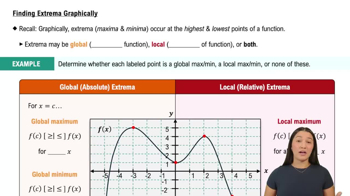Table of contents
- 0. Functions7h 52m
- Introduction to Functions16m
- Piecewise Functions10m
- Properties of Functions9m
- Common Functions1h 8m
- Transformations5m
- Combining Functions27m
- Exponent rules32m
- Exponential Functions28m
- Logarithmic Functions24m
- Properties of Logarithms34m
- Exponential & Logarithmic Equations35m
- Introduction to Trigonometric Functions38m
- Graphs of Trigonometric Functions44m
- Trigonometric Identities47m
- Inverse Trigonometric Functions48m
- 1. Limits and Continuity2h 2m
- 2. Intro to Derivatives1h 33m
- 3. Techniques of Differentiation3h 18m
- 4. Applications of Derivatives2h 38m
- 5. Graphical Applications of Derivatives6h 2m
- 6. Derivatives of Inverse, Exponential, & Logarithmic Functions2h 37m
- 7. Antiderivatives & Indefinite Integrals1h 26m
- 8. Definite Integrals3h 25m
5. Graphical Applications of Derivatives
Intro to Extrema
Problem 3.6.58d
Textbook Question
{Use of Tech} Flow from a tank A cylindrical tank is full at time t=0 when a valve in the bottom of the tank is opened. By Torricelli’s law, the volume of water in the tank after t hours is V=100(200−t)², measured in cubic meters.
d. At what time is the magnitude of the flow rate a minimum? A maximum?
 Verified step by step guidance
Verified step by step guidance1
First, differentiate the volume function V(t) = 100(200 - t)² with respect to time t to find the flow rate, which is given by the derivative dV/dt.
Next, apply the chain rule to differentiate the function: dV/dt = 100 * 2(200 - t)(-1).
Simplify the expression for the flow rate to get dV/dt = -200(200 - t).
To find the critical points where the flow rate is at a minimum or maximum, set the derivative dV/dt equal to zero and solve for t.
Finally, analyze the second derivative or use the first derivative test to determine whether the critical points correspond to a minimum or maximum flow rate.
Recommended similar problem, with video answer:
 Verified Solution
Verified SolutionThis video solution was recommended by our tutors as helpful for the problem above
Video duration:
2mPlay a video:
Was this helpful?

 5:58m
5:58mWatch next
Master Finding Extrema Graphically with a bite sized video explanation from Callie
Start learning





